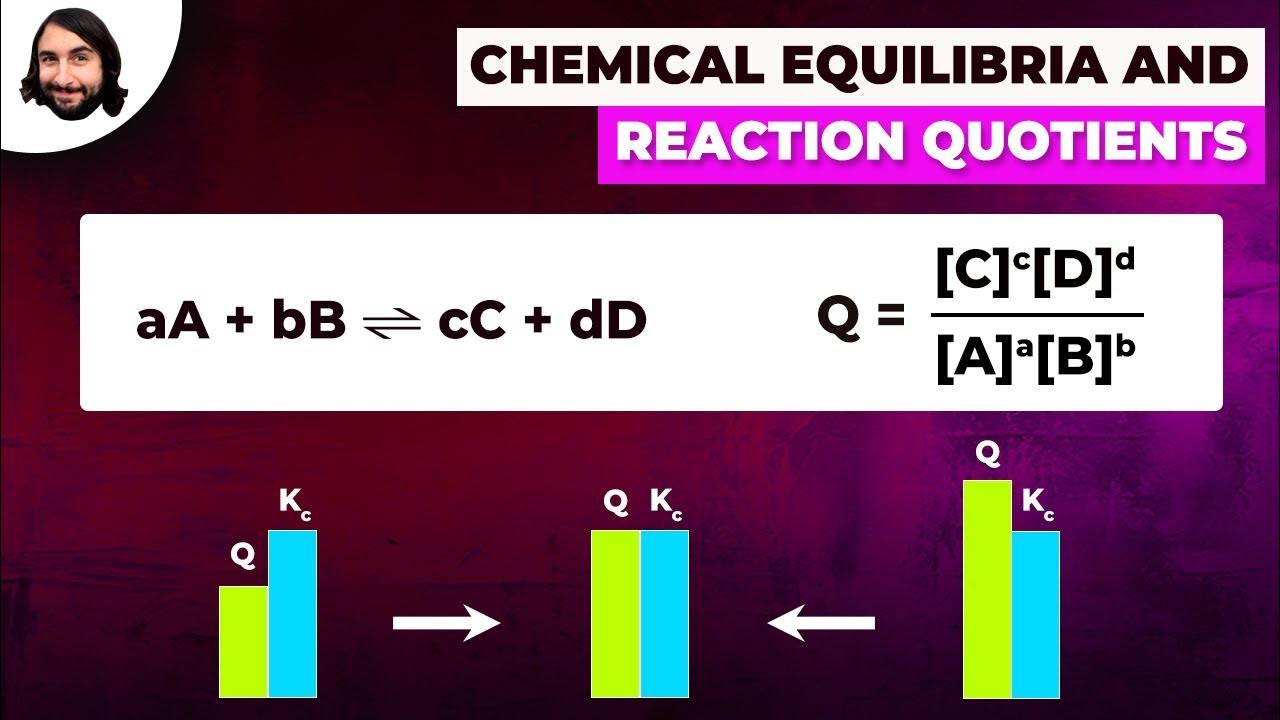Interpretação da Constante de Equilíbrio
Summary
TLDRIn this lesson, we explore how to interpret the equilibrium constant (Kc) of a reversible reaction. By understanding how to calculate Kc using the concentrations of reactants and products, we learn that Kc values greater than 1 indicate that products are favored at equilibrium, while values less than 1 suggest reactants are favored. The lesson also discusses how temperature influences Kc, with reactions often favoring either the forward or reverse direction based on temperature changes. Through examples, we highlight key concepts, including the synthesis of ammonia and its temperature dependence, preparing students for further exercises on chemical equilibrium.
Takeaways
- 😀 The equilibrium constant (Kc) of a reversible reaction is calculated using the concentrations of products and reactants raised to their respective stoichiometric coefficients.
- 😀 In a reaction at equilibrium, the concentrations of reactants and products remain constant over time.
- 😀 The value of Kc helps determine the balance between products and reactants at equilibrium.
- 😀 A large Kc value (much greater than 1) indicates that the products are favored at equilibrium, while a small Kc value (much less than 1) suggests that the reactants are favored.
- 😀 The equilibrium constant is only affected by changes in temperature, not by changes in concentration or pressure.
- 😀 For reactions with a Kc greater than 1, the forward reaction is favored, leading to a higher concentration of products.
- 😀 For reactions with a Kc less than 1, the reverse reaction is favored, and the concentration of reactants is higher at equilibrium.
- 😀 When calculating Kc for a reaction, concentrations of solids and liquids are not included in the equation; only gases and aqueous substances are considered.
- 😀 The effect of temperature on the equilibrium constant varies by reaction type; in some cases, increasing temperature increases Kc, while in others, it decreases Kc.
- 😀 In the synthesis of ammonia, higher temperatures decrease Kc, favoring the reverse reaction, so lower temperatures are preferred for optimal ammonia production.
Q & A
What is the equilibrium constant (Kc) in a reversible chemical reaction?
-The equilibrium constant (Kc) is defined as the product of the concentrations of the products raised to their respective stoichiometric coefficients, divided by the product of the concentrations of the reactants raised to their respective stoichiometric coefficients.
How do you calculate the equilibrium constant for the reaction involving ICl, I2, and Cl2?
-The equilibrium constant Kc for the reaction involving ICl, I2, and Cl2 is given by the formula: Kc = [ICl]^2 / ([I2] * [Cl2]), where the concentrations are raised to the power of their respective stoichiometric coefficients.
How can you determine when a reversible reaction has reached equilibrium?
-You can determine when a reversible reaction has reached equilibrium by observing that, after a certain point, the concentrations of both the reactants and the products remain constant over time.
What does a large value of Kc (much greater than 1) indicate about the equilibrium of a reaction?
-A large value of Kc (much greater than 1) indicates that, at equilibrium, the concentration of the products is much greater than the concentration of the reactants, meaning the equilibrium favors the forward reaction.
What does a small value of Kc (much less than 1) indicate about the equilibrium of a reaction?
-A small value of Kc (much less than 1) indicates that, at equilibrium, the concentration of the reactants is much greater than the concentration of the products, meaning the equilibrium favors the reverse reaction.
Why is water not included in the expression for Kc when calculating the equilibrium constant?
-Water is not included in the expression for Kc because it is considered a pure liquid in most reactions, and its concentration remains constant during the reaction, so it does not affect the equilibrium constant.
How does temperature affect the equilibrium constant (Kc) of a reaction?
-The only factor that can alter the equilibrium constant is temperature. Depending on the reaction, increasing the temperature can either increase or decrease the value of Kc, thus favoring the forward or reverse reaction.
What does it mean if the equilibrium constant (Kc) increases with temperature?
-If the equilibrium constant (Kc) increases with temperature, it means that the forward reaction is favored at higher temperatures, leading to a higher concentration of products at equilibrium.
What does it mean if the equilibrium constant (Kc) decreases with temperature?
-If the equilibrium constant (Kc) decreases with temperature, it means that the reverse reaction is favored at higher temperatures, leading to a higher concentration of reactants at equilibrium.
Why is it recommended to conduct the synthesis of ammonia at lower temperatures for better yield?
-It is recommended to conduct the synthesis of ammonia at lower temperatures because, at lower temperatures, the equilibrium constant (Kc) favors the formation of ammonia (the forward reaction), resulting in a better yield of ammonia.
Outlines

This section is available to paid users only. Please upgrade to access this part.
Upgrade NowMindmap

This section is available to paid users only. Please upgrade to access this part.
Upgrade NowKeywords

This section is available to paid users only. Please upgrade to access this part.
Upgrade NowHighlights

This section is available to paid users only. Please upgrade to access this part.
Upgrade NowTranscripts

This section is available to paid users only. Please upgrade to access this part.
Upgrade NowBrowse More Related Video

Reaksi Kesetimbangan | Tetapan Kesetimbangan Kc | Kimia kelas 11

Chemical Equilibria and Reaction Quotients

Kesetimbangan Kimia| Kimia SMA | Tetty Afianti

PERHITUNGAN TETAPAN KESETIMBANGAN BERDASARKAN KONSENTRASI (Kc)

Kesetimbangan Kimia • Part 3: Tetapan Kesetimbangan Pada Reaksi Berkaitan / Hukum Hess

PENGERTIAN DAN TETAPAN KESETIMBANGAN (Kc)
5.0 / 5 (0 votes)